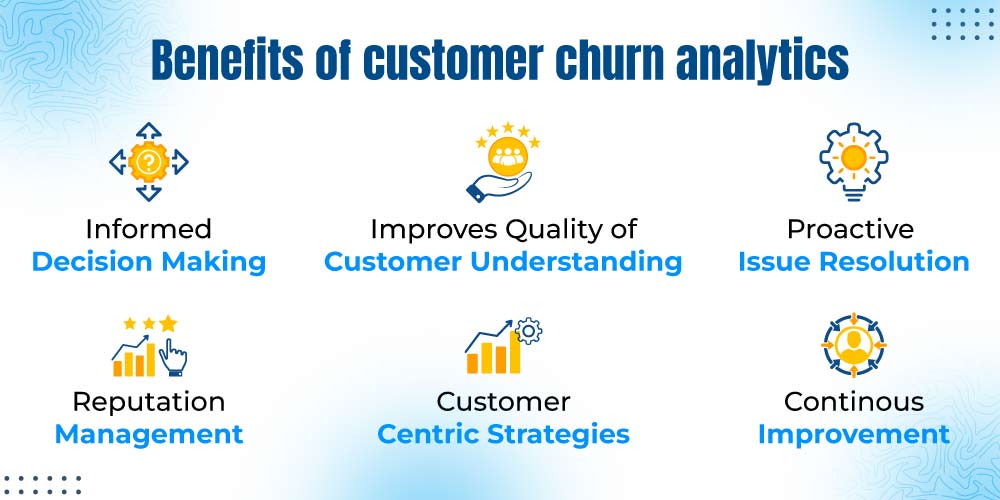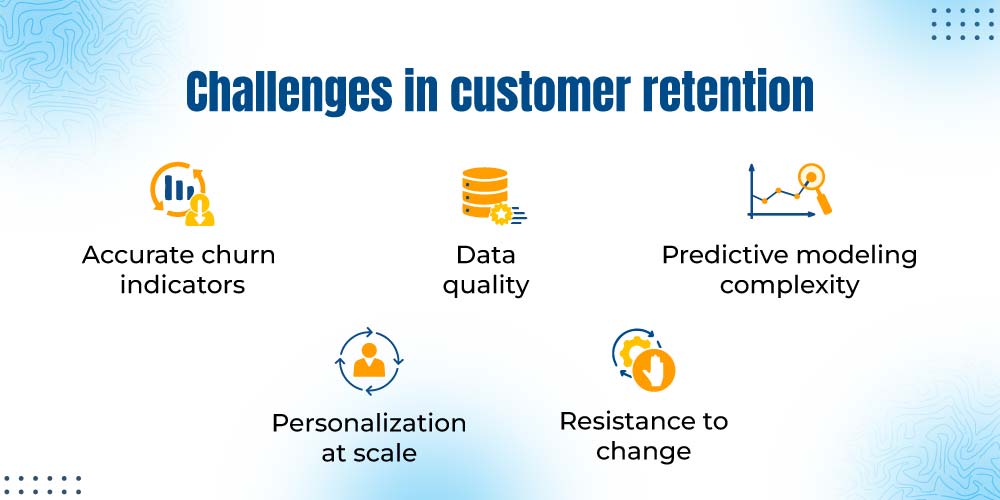Use Analytics to Identify and Reduce Customer Churn
Introduction:
Customer churn, the phenomenon of customers leaving a business, can have a significant impact on your bottom line. It’s not just about losing revenue, it’s also about losing valuable customer relationships. In this digital age, businesses have a powerful ally in their battle against churn which is analytics. Analytics can help you not only identify customers at risk of churning but also develop strategies to retain them. In this blog, we’ll explore the importance of reducing customer churn and how analytics can be the secret weapon.


Why is it important to reduce customer churn:
Customer churn can have dire consequences, impacting revenue and profitability. Retaining existing customers is often more cost-effective than acquiring new ones. By reducing churn, you can build a loyal customer base that serves as a consistent revenue source.
In the dynamic landscape of business, where customer expectations evolve and competition intensifies, the role of data in reducing customer churn cannot be overstated. Here’s why investing in comprehensive data collection is a strategic imperative:
1. Informed Decision-Making:
Data is the compass that guides informed decision-making. By leveraging website analytics, companies gain insights into customer behaviors, preferences, and pain points. This knowledge empowers strategic decisions, ensuring that resources are allocated where they matter most, addressing customer needs effectively.
2. Improves quality of customer understanding:
Integrating the CRM system with various data sources provides a 360-degree view of customer interactions. This holistic understanding allows companies to tailor their approach across multiple touchpoints, creating a seamless and personalized customer experience. The ability to anticipate and meet customer expectations is a powerful tool in reducing churn.
3. Proactive Issue Resolution:
Surveys, support tickets, and social media listening serve as early warning systems. Companies can identify and address issues before they escalate, demonstrating a proactive commitment to customer satisfaction. This not only resolves immediate concerns but also builds trust, fostering long-term customer loyalty.
4. Reputation Management:
Social media listening tools are indispensable for monitoring brand sentiment. In the era of instant communication, a positive online reputation is vital. By tracking conversations about the brand, companies can respond promptly to both positive and negative feedback, shaping a favorable image and mitigating potential churn triggers.
5. Continuous Improvement:
Data collection is not a one-time effort but a continuous process. Regularly analyzing customer data allows companies to adapt to changing trends and preferences. This iterative approach ensures that strategies for churn reduction remain relevant and effective over time.
6. Customer-Centric Strategies:
By prioritizing data collection, companies signal a commitment to being customer-centric. Understanding and responding to customer needs creates a positive feedback loop, enhancing customer satisfaction and loyalty. This customer-centric approach is a foundational element in the battle against customer churn.
How can analytics be used to identify and reduce customer churn
Analytics empowers businesses to predict and prevent churn by collecting and analyzing customer data. With the right analytics tools and strategies, you can pinpoint the customers most likely to churn and tailor your efforts to retain them. Let’s delve into the steps you can take to leverage analytics effectively.
How to Collect Data on Your Customers and Their Behavior:
To begin your journey in churn reduction, you need data – lots of it. Gathering data on customer behavior is the first step. Utilize website analytics, such as Google Analytics, to track how visitors interact with your website. Additionally, integrating your CRM system with various data sources allows you to monitor customer interactions across channels like email, phone, and social media. Collect customer feedback through surveys and support tickets, and use social media listening tools to track conversations about your brand online.
How to Identify Metrics that Indicate Churn Risk:
Identifying the right metrics is pivotal. Key indicators often include customer lifetime value (CLV), customer engagement, and customer satisfaction. CLV helps you identify high-value customers worth retaining. Customer engagement measures how deeply customers interact with your product or service, with low engagement being a churn risk. Customer satisfaction, naturally, reveals potential churners. Additionally, metrics like days since the last login, support tickets, and negative reviews can provide valuable insights.
Identifying and understanding the right metrics is like having a crystal ball that reveals potential churn risks. Let’s break down the key indicators and why they matter with an example :
1. Customer Lifetime Value (CLV):
- What it is: CLV represents the total revenue a customer is expected to generate throughout their entire relationship with your company.
- Why it matters: High CLV indicates valuable, loyal customers worth retaining.
- Example: Imagine Customer A, who consistently purchases high-value products and engages with your brand over several years. Their high CLV suggests they are a crucial asset to retain.
2. Customer Engagement:
- What it is: This measures how deeply customers interact with your product or service.
- Why it matters: Low engagement can signal a churn risk, as it indicates a lack of interest or utilization.
- Example: If users signed up for your software but rarely use its features, there’s a risk they might seek alternatives. Monitoring engagement helps you intervene before they disengage completely.
3. Customer Satisfaction:
- What it is: A measure of how satisfied customers are with your products or services.
- Why it matters: Dissatisfied customers are likely to churn, impacting your retention rates.
- Example: Surveying customers after a support interaction can reveal satisfaction levels. If responses indicate dissatisfaction, it’s a red flag for potential churn.
4. Days Since Last Login:
- What it is: The number of days since a customer last logged into your platform.
- Why it matters: Long periods of inactivity may indicate a declining interest.
- Example: If a customer who used to log in weekly hasn’t accessed your platform in a month, it suggests they might be losing interest.
5. Support Tickets:
- What it is: The number and nature of support tickets submitted by a customer.
- Why it matters: Frequent or unresolved issues may contribute to dissatisfaction and, ultimately, churn.
- Example: A sudden surge in support tickets from a previously satisfied customer may indicate a problem that needs attention.
6. Negative Reviews:
- What it is: Public expressions of dissatisfaction on review platforms or social media.
- Why it matters: Negative reviews can influence the perception of your brand and contribute to churn.
- Example: Monitoring negative reviews can help identify areas for improvement. If multiple customers complain about a specific issue, addressing it proactively can prevent further churn.
How to Segment Your Customers Based on Their Churn Risk:
Once you’ve collected data and identified churn indicators, it’s time to segment your customers. Utilize customer segmentation tools and categorize customers into high, medium, and low-risk groups. The focus should be on the high-risk customers, where your churn reduction efforts will have the most significant impact.
How to Analyze the Data to Identify the Root Causes of Churn:
Understanding the “why” behind churn is vital. Data visualization tools create charts and graphs, revealing trends and correlations. Look for connections between churn risk metrics and other factors like demographics, product usage patterns, and customer service interactions. Dive deeper by conducting surveys and interviews to gain profound insights into why customers are leaving.
Customer retention Analytics best practices :
Armed with insights, it’s time to take action. Develop targeted churn prevention campaigns tailored to each customer segment. For instance, offer special promotions to high-risk customers or create personalized content. Continuously improve your product or service based on customer feedback, and provide excellent customer service to resolve issues efficiently. Implement customer loyalty programs to reward ongoing business.
Specific Examples of How to Use Analytics to Reduce Customer Churn :
Predictive analytics takes your churn reduction efforts to the next level. Machine learning models predict which customers are most likely to churn based on their CLV, engagement, satisfaction, and other churn risk metrics. Customer segmentation targets personalized churn reduction campaigns effectively. Use customer feedback to address root causes of churn, such as improving customer service based on customer feedback.
How to Get Started with Using Analytics to Reduce Customer Churn :
Ready to embark on your journey to reduce churn with analytics? Start by exploring analytics platforms, considering whitepapers on the topic, or scheduling a demo with an analytics expert. These steps will set you on the path to churn reduction success.


Common Challenges of Reducing Customer Churn and How to Overcome Them :
While using analytics to reduce churn offers immense potential, you may face challenges such as identifying accurate churn indicators, data quality, predictive modeling complexity, personalization at scale, and resistance to change. Overcoming these challenges requires a combination of data-driven strategies, organizational adaptability, and effective resource allocation.
1. Identifying Accurate Churn Indicators:
- Challenge: Pinpointing the right metrics that accurately predict churn can be like finding a needle in a haystack.
- Strategy: Conduct thorough analyses to understand your unique business landscape. Experiment with different combinations of metrics and use historical data to refine your model continuously.
2. Data Quality:
- Challenge: Garbage in, garbage out. Inaccurate or incomplete data can lead to flawed insights.
- Strategy: Implement robust data quality processes. Regularly audit and clean your data, ensuring it’s accurate and up-to-date. Invest in data validation tools to catch errors early in the data collection process.
3. Predictive Modeling Complexity:
- Challenge: Building and maintaining complex predictive models can be resource-intensive.
- Strategy: Prioritize simplicity and interpretability in your models. Leverage machine learning tools that balance accuracy with ease of understanding. Regularly reassess and update models to stay ahead of evolving customer behaviors.
4. Personalization at Scale:
- Challenge: Tailoring interventions to each customer at scale can be daunting.
- Strategy: Embrace automation and artificial intelligence. Leverage machine learning algorithms to analyze vast datasets and personalize customer interactions. Implement scalable communication strategies that dynamically adapt based on individual customer behaviors.
5. Resistance to Change:
- Challenge: Employees and processes resistant to adopting data-driven strategies can hinder progress.
- Strategy: Foster a culture of data-driven decision-making. Invest in training programs to upskill your workforce on the benefits of analytics. Highlight success stories that demonstrate the positive impact of data-driven strategies on reducing churn.
In the face of these challenges, success lies in a combination of data-driven strategies, organizational adaptability, and effective resource allocation. Embrace a mindset of continuous improvement, where challenges become opportunities to refine and enhance your churn reduction strategies.
Learn more about Data Analytics And Insights in our latest blog.
Conclusion:
Reducing customer churn is not just about saving revenue; it’s about fostering long-lasting customer relationships. By harnessing the power of analytics, you can proactively identify and address churn risks, ensuring your customer base remains loyal and your business thrives.







